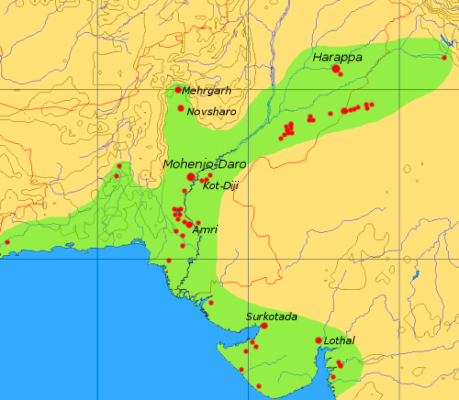55 Cities of the Indus Valley Civilization
Learning Objective
- Explain the significance of the urban centers in the IVC
Key Points
- The Indus Valley Civilization contained more than 1,000 cities and settlements.
- These cities contained well-organized wastewater drainage systems, trash collection systems, and possibly even public granaries and baths.
- Although there were large walls and citadels, there is no evidence of monuments, palaces, or temples.
- The uniformity of Harappan artifacts suggests some form of authority and governance to regulate seals, weights, and bricks.
Terms
urban planning
A technical and political process concerned with the use of land and design of the urban environment that guides and ensures the orderly development of settlements and communities.
granaries
A storehouse or room in a barn for threshed grain or animal feed.
citadels
A central area in a city that is heavily fortified.
Harappa and Mohenjo-daro
Two of the major cities of the Indus Valley Civilization during the Bronze Age.
By 2600 BCE, the small Early Harappan communities had become large urban centers. These cities include Harappa, Ganeriwala, and Mohenjo-daro in modern-day Pakistan, and Dholavira, Kalibangan, Rakhigarhi, Rupar, and Lothal in modern-day India. In total, more than 1,052 cities and settlements have been found, mainly in the general region of the Indus River and its tributaries. The population of the Indus Valley Civilization may have once been as large as five million.

The remains of the Indus Valley Civilization cities indicate remarkable organization; there were well-ordered wastewater drainage and trash collection systems, and possibly even public granaries and baths. Most city-dwellers were artisans and merchants grouped together in distinct neighborhoods. The quality of urban planning suggests efficient municipal governments that placed a high priority on hygiene or religious ritual.
Infrastructure
Harappa, Mohenjo-daro, and the recently, partially-excavated Rakhigarhi demonstrate the world’s first known urban sanitation systems. The ancient Indus systems of sewerage and drainage developed and used in cities throughout the Indus region were far more advanced than any found in contemporary urban sites in the Middle East, and even more efficient than those in many areas of Pakistan and India today. Individual homes drew water from wells, while waste water was directed to covered drains on the main streets. Houses opened only to inner courtyards and smaller lanes, and even the smallest homes on the city outskirts were believed to have been connected to the system, further supporting the conclusion that cleanliness was a matter of great importance.
Architecture
Harappans demonstrated advanced architecture with dockyards, granaries, warehouses, brick platforms, and protective walls. These massive walls likely protected the Harappans from floods and may have dissuaded military conflicts. Unlike Mesopotamia and Ancient Egypt, the inhabitants of the Indus Valley Civilization did not build large, monumental structures. There is no conclusive evidence of palaces or temples (or even of kings, armies, or priests), and the largest structures may be granaries. The city of Mohenjo-daro contains the “Great Bath,” which may have been a large, public bathing and social area.

Authority and Governance
Archaeological records provide no immediate answers regarding a center of authority, or depictions of people in power in Harappan society. The extraordinary uniformity of Harappan artifacts is evident in pottery, seals, weights, and bricks with standardized sizes and weights, suggesting some form of authority and governance.
Over time, three major theories have developed concerning Harappan governance or system of rule. The first is that there was a single state encompassing all the communities of the civilization, given the similarity in artifacts, the evidence of planned settlements, the standardized ratio of brick size, and the apparent establishment of settlements near sources of raw material. The second theory posits that there was no single ruler, but a number of them representing each of the urban centers, including Mohenjo-daro, Harappa, and other communities. Finally, experts have theorized that the Indus Valley Civilization had no rulers as we understand them, with everyone enjoying equal status.
Sources

